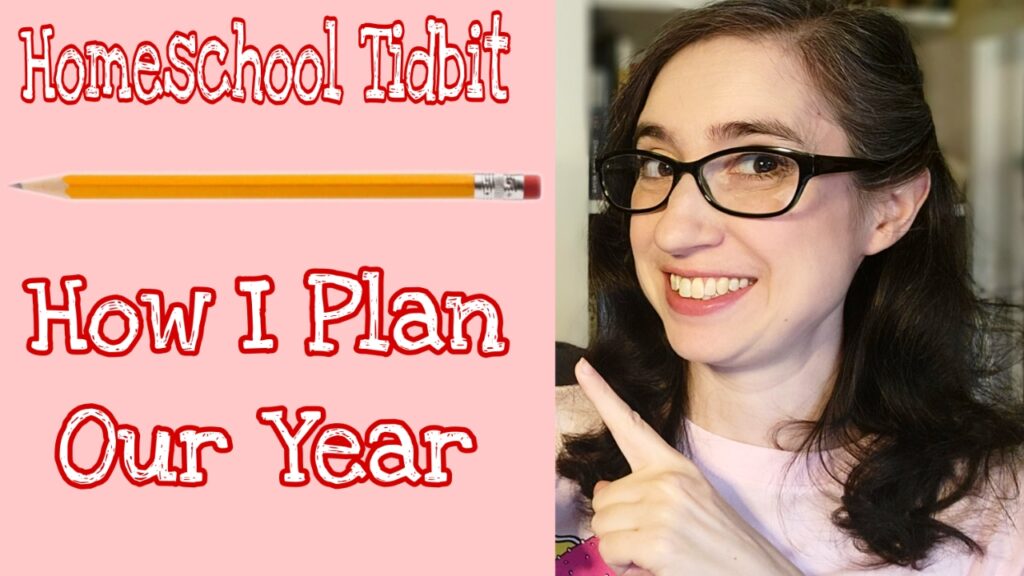Homeschool Tidbits: How I Plan Our School Year
August 18, 2023

Welcome to Build Your Library’s Homeschool Tidbits: Episode 55 – How I Plan Our School Year. In this weekly video series, I will delve briefly into a topic related to homeschooling and will share some of my knowledge and expertise as a long-time homeschooling mother of 4 children. Three of whom have graduated high school and one who is a college graduate!
I’ve talked about how I use notebooks for planning, and in my last tidbit, I talked about big-picture planning for high school. Today, I wanted to chat about how I plan out a single year. I’m going to try to walk you through my process in a coherent way. The key factor I want you to keep in mind as I am sharing is that this is how I do it – it isn’t how I think everyone SHOULD do it. What I do is pretty simple and that works best for me.
Step 1: Assess Our Needs and Goals
My first step is always to assess our needs for this school year. So, I look back on our last year and think about how that went. I think about what did and did not work for us. Do I need to change anything? Was there something that worked really well that we should continue?
Then I consider our goals – both big and small. What needs to happen this year for us to reach those big goals? Where do we want to put our focus?
To give you an example, this year will be my youngest daughter’s 9th-grade year. This is the year we are going to really hone her writing skills, so that will be a major focus for us this year.
I also made the decision to switch math curriculum – we’d been using Teaching Textbooks for years and she had been getting really frustrated by it lately. Math started taking over our school day, so this year we are trying out Denison Algebra. I’ve heard really good things from my friend Arlene at Arlene and Company – she has a whole video walkthrough of Denison Algebra if you want to check that out!
I also always give my daughter the opportunity to choose what she wants to learn. I want her to participate in her education, and sometimes that means shaking up my plans. I offer suggestions of course, but ultimately, I try to honor her wishes. I suggested we could do either Level 8 or Level 9 and she, always being the kid that keeps me on my toes, requested we do both. She also wants to learn how to code.
I look at all of these things as a puzzle. I now have a whole bunch of working pieces. How will turn all of this into our working routine?
Step 2: Dump out all the Puzzle Pieces
Now I’ve looked over what we plan to study this year and collected materials. It’s time to organize!
This is super easy if you are using a curriculum like Build Your Library – as I’ve already started the puzzle for you. All you need to figure out is how to schedule out your math and any other additional pieces you’ve added.
Since my daughter wants to do 2 levels, I’m working on creating a hybrid version for her – will we be able to get to all of it in a school year? I have no idea, but we’ll definitely give it a try.
This is when I sit down with my planner and piece everything together. I’m making a skeleton of our year. A list, really. How much math will we be able to do in a week? How long will this book take to read? How many writing assignments will I assign? What books do I want us to read together?
It’s really easy to over-plan and to be fair, I’m notorious for over-planning, but honestly, that’s ok. We’re looking for balance, and by the time we’re through this planning process, we’ll find that.
This is also when I also set up our materials – we use utility carts to hold and organize everything, but maybe you have a school room, a shelf, or a desk where you keep your materials. It’s time to get everything set up and looking good! This is what gives everyone (especially me!) motivation – having a pretty space all setup and ready for us.
Step 3: Map Out Week 1
Resist the urge to plan out the entire year all at once. Seriously. Just plan out your first week – and do it in pencil, or erasable pen. Trust me. This gives you an idea of what your expectations are at the start of your year. Plan out everything in detail – the books you are reading together, independent reading, how many chapters of history and science, art projects, anything, and everything you hope to accomplish. Dream big!
This dream version of your homeschool year will be a test run for your plans. Writing in pencil means you can erase as you work and you won’t feel like a failure for not living up to your dream of a perfectly balanced (or let’s be honest with ourselves, an overplanned) school year.
Step 4: Get Started!
Some people might have another step in between, but that just isn’t how my brain works. I can organize our materials and dream up exciting plans, but the actual nitty-gritty comes into play once we begin our year. This is when I see what materials are actually going to work well for us and what we’ll end up setting aside. I’ll be able to see how our routine will come together – it’s rarely what I dreamed up on paper.
I need to actually do the things for at least a week or two before I can reasonably assess everything and start coming up with a daily routine that will work well for us.
It might take two or three weeks to figure out your routine, and that’s fine! Those first weeks are an adjustment, especially if you took the summer off or you are just starting out. But once you fall into that routine…things start to feel better. Now you can switch to writing out your plans in ink if you prefer because you have a better feel for what works.
Final Thoughts
Do you need a fancy planner or computer program? No. But I still like to have a nice notebook planner to help me with the big-picture plan, and if you enjoy that, by all means, use one. I really like the SchoolNest planner for that reason. But you don’t need to spend a lot of money on planners and apps unless that is something that really works well for you. You could do the same thing with a calendar and a spiral-bound notebook.
It might take you a few years and playing with different planning methods before you hit on what works best for you. Personally, I’m a fan of simplicity. The more complicated it is, the less likely I am to use it. Keep it simple and you’ll be able to stay the course.
Coming up next…
I hope you found this Tidbit helpful! Come back next week for more homeschooling inspiration!
Until then, happy reading!
See Other Related Articles:
- Happy, Hygge Homeschooling?
- “Are worms made out of metal?” And other great rabbit trails.
- Charlotte Mason in the Secular Homeschool
- A Literary Education book
- About Build Your Library
- Homeschool Tidbits: Build Your Library’s Weekly Video Blog Series
.
 Emily Cook is the author and creator of the secular homeschool curriculum Build Your Library, a literature-based K-12 program infused with the teachings of Charlotte Mason. She writes full-year lesson plans as well as shorter topical unit studies. Emily has been homeschooling her four children in Southern NH for 21 years. She is passionate about reading aloud to children of all ages and loves to share her love of literature with others. She and her family also make incredibly dorky videos about homeschooling, books, and more on Youtube at ARRRGH! Schooling. You can follow her on Facebook, Twitter, and Pinterest. You can also check out her author page on Amazon.
Emily Cook is the author and creator of the secular homeschool curriculum Build Your Library, a literature-based K-12 program infused with the teachings of Charlotte Mason. She writes full-year lesson plans as well as shorter topical unit studies. Emily has been homeschooling her four children in Southern NH for 21 years. She is passionate about reading aloud to children of all ages and loves to share her love of literature with others. She and her family also make incredibly dorky videos about homeschooling, books, and more on Youtube at ARRRGH! Schooling. You can follow her on Facebook, Twitter, and Pinterest. You can also check out her author page on Amazon.
